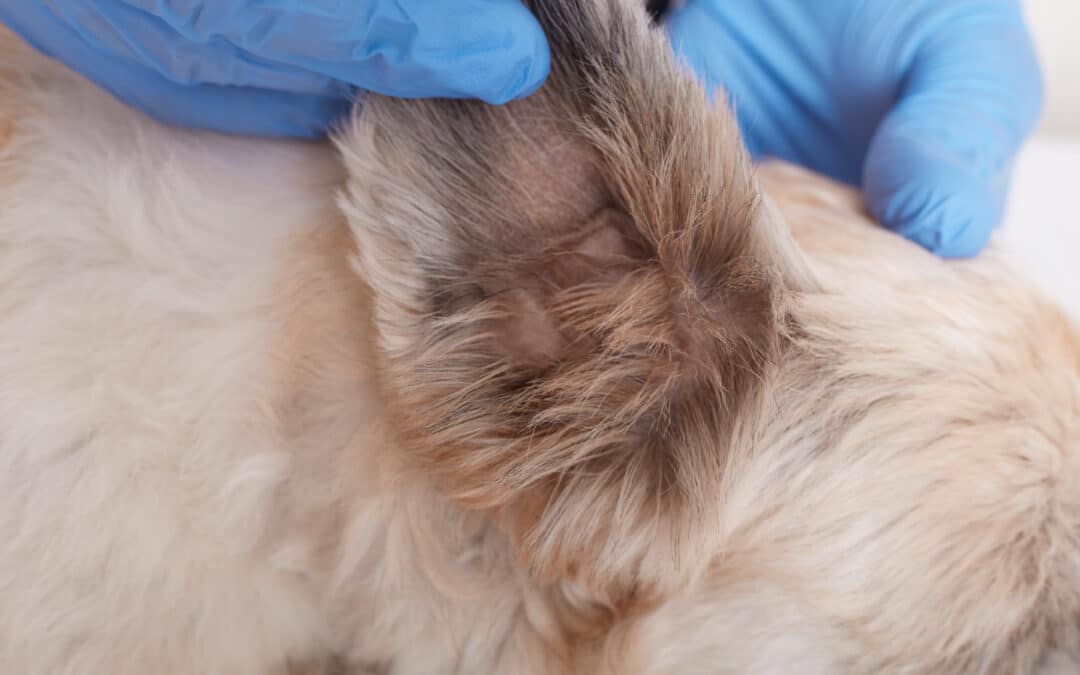Ear mites in dogs can be a mystery if you have never dealt with them.
While these pesky critters can infest your dog’s ears, they can do more harm than just offering your pet an itchy annoyance. If your dog has ear mites, what do you do? How do you treat it?
Here’s everything you need to know about ear mites in dogs.
What Are Ear Mites?
Table of Contents
Let’s start by answering, ‘What are ear mites?’
Ear mites are tick-like insects that infest your pets’ ears. Unlike ticks, they can be hard to spot without a microscope. The most effective way to confirm your dog has them is by magnifying an earwax sample.
You may notice whitish dots in your dog’s ears. A more obvious sign is spotting black discharge. Many owners describe it as resembling coffee grounds.
While it’s hard to spot on animals with dark fur, this is usually how pet owners diagnose ear mites at home.
How Do Dogs Get Ear Mites?

How do dogs get ear mites in the first place?
Ear mites are arachnids with no qualms about migrating from one animal to another. Try as you might, it can be tricky to spot this happening.
Dogs can become infected with ear mites through regular activities, such as playing with other dogs or going on a walk outside. Contact with puppies or other dogs who are already infected is the typical cause, but they can also contract them through infested bedding and toys.
What Are the Symptoms of Ear Mites?
Another thing you need to know is what to look for when assessing your dog for ear mites.
For instance, when distinguishing between ear mites vs a yeast infection, how can you tell the difference?
The primary difference is in the symptoms. Symptoms of ear mite infestation include:
- Scratching ears
- Head shaking
- Hair loss from over-grooming/scratching
- Blisters on ears
- Dark waxy discharge resembling coffee grounds
- White speck inside ears
Depending on the severity of the ear mites, you may notice bald spots on other parts of your dog, like:
- Base of tail
- Under arms
- On belly
That’s not because the ear mites have spread. It’s because your pet is trying to self-soothe by grooming itself. Ear mites cause stress, and grooming is nature’s remedy for canine or feline anxiety.
So that’s how to recognize ear mites. Here, comparatively, are the symptoms of a yeast infection:
- Change in skin pigmentation
- Greasy/oily skin
- Head shaking/tilting
- Scratching
- Drooling
- Localized alopecia
- Odor
Notice that while some of the symptoms are similar, there are several symptoms of a yeast infection you won’t see in cases of ear mites.
How Can You Treat Ear Mites in Dogs?
Once you confirm your dog has ear mites, your next action should be to call the vet. If nothing else, ear mites are contagious and uncomfortable.
If they escalate, the blisters and alopecia can cause secondary infections.
So, how can you treat ear mites?
Licensed vets recommend many different products. You can’t treat the egg stage of an ear mite, so you want to kill the adults and larvae as soon as possible. Usually, this involves using an insecticide like Bravecto for dogs.
While safe, many people wonder, can Bracecto kill dogs? This isn’t true, but if you don’t feel comfortable, it’s important to know there are effective alternative treatments.
Whether you apply these daily, topically, or spray inside your pet’s ears depends on the treatment prescribed.
What is the Life Cycle of Mites in Dogs?
Ear mites have five distinct stages:
- Eggs
- Larvae
- Molts
- Nymphs
- Adults
Adult ear mites promptly mate, and if female, they lay eggs in dogs’ ear canals. Depending on the severity of the infestation, they may spread across a pet’s face. Consequently, you must treat ear mites as soon as you notice the symptoms.
Eggs take four days to hatch, so when untreated, your dog can become riddled with ear mites.
Are Ear Mites Dangerous?
As illnesses go, there are more significant health issues than ear mites in dogs. But they are one of the most uncomfortable.
There is also a chance that blisters and wounds from constraint scratching become infected. When that happens, your pet needs antibiotic care on top of ear mite treatments. Your trusted veterinarian can prescribe medication and treatments for your dog to rid them of the mites, typically an insecticide.
Can Dogs Get Ear Mites From Dogs
Dogs typically contract ear mites from other dogs. Ear mites are extremely contagious, and are unconcerned about whose ears they live in (the notable exception is people). A pet can transmit ear mites to a person, but instances of this happening are rare.
When dogs play with or share toys/bedding with other infected dogs, they will contract ear mites that will then lay eggs that hatch into larvae and spread the infection. You can prevent this
Mites in Dogs vs. Mites in Cats
By now, we have discussed treatment for ear mites and whether dog ear mites are contagious. What we haven’t explored is how cats and dogs experience ear mites differently.
What Are the Similarities?
Let’s start with what cat and dog ear mites have in common.
While cats and dogs experience ear mites differently, they share:
- Ability to transmit ear mites to the other species
- A propensity for red, itchy ears
- Likelihood of developing bacterial/fungal infection due to prolonged ear mite symptoms/exposure
What Are the Differences?
That said, there are some differences between ear mites in dogs and cats.
The primary difference is that feline ear mites are more persistent and resist treatment.
Consequently, there are more treatments for ear mites in dogs than in cats.
But the biggest difference is the medicines themselves. Despite ear mites being toxicologically the same in cats and dogs, vets prescribe different medications depending on the animal that presents with them.
Key Takeaways on Mites
If you want a more in-depth look, check out: surface mites in dogs clinical article.
The crucial thing to remember is that the longer you leave ear mites, the higher the chances of complications like a bacterial or fungal infection.
Dogs can get ear mites from other dogs. Immediate treatment helps limit your pets’ exposure to ear mites.
Finally, never try to treat ear mites at home. While many medications exist, the one that’s right for your dog is often species-dependent, so it’s important to consult a veterinarian who can prescribe the correct treatments and medications.








